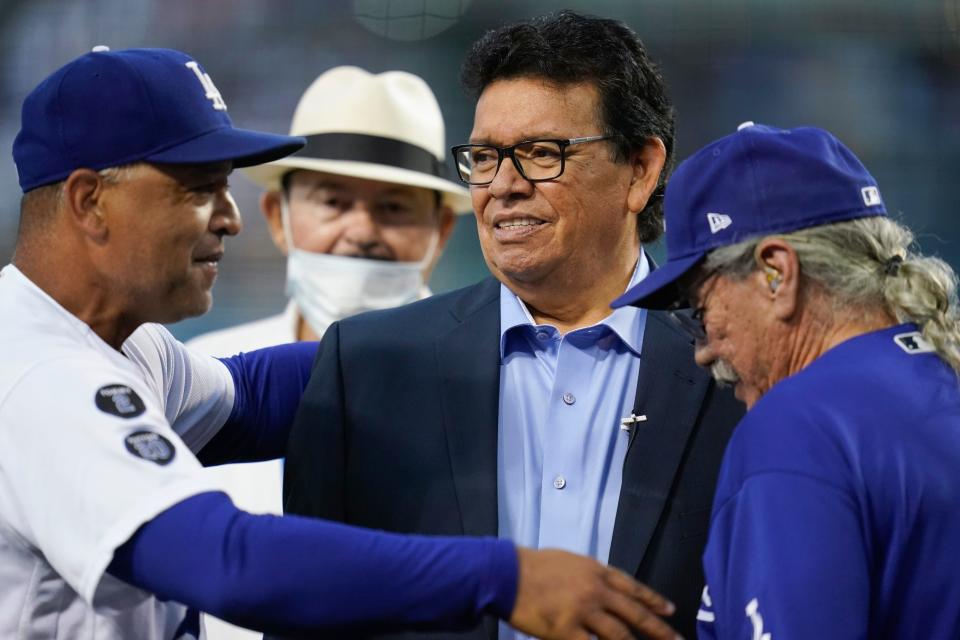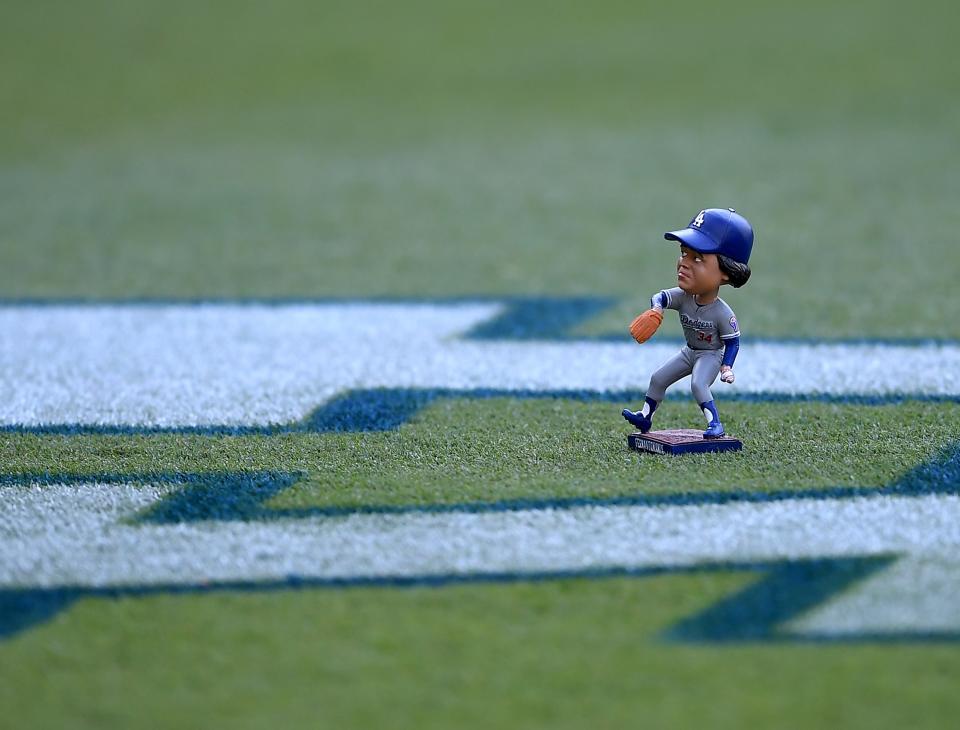Fernando Valenzuela's impact can be seen in ballparks and beyond 40 years after Fernandomania
LOS ANGELES – Inside Dodger Stadium, the man who triggered Fernandomania snapped his fingers.
“Like that,’’ Fernando Valenzuela said of the passage of time. “It went so fast."
Forty years ago, he was the 20-year-old rookie, bursting on the scene as Major League Baseball’s first Mexican superstar. He spoke little English but captivated this city and baseball fans across the country with the unprecedented things did on the pitcher’s mound.
There was the funky windup, with the high leg kick and Valenzuela looking skyward before he delivered his next pitch. There was his screwball, at times virtually unhittable as it spun out of Valenzuela’s left hand. And there was his 8-0 start with five shutouts and a 0.50 ERA during that stretch in 1981 when Fernandomania took hold.
On days Valenzuela was scheduled to pitch, the crowd at Dodger Stadium grew by thousands. Some fans carried Mexican flags, making it even clearer who they were there to see: Fernando, the chubby, black-haired pitcher who as a rookie won the National League Rookie of the Year Award, the National League Cy Young Award and a World Series ring, all while squeezing in a trip to the White House at the invitation of then-President Ronald Reagan.
“It was a cultural and linguistic earthquake that shook the baseball world,’’ Richard Santillan, a founding member of the Latino Baseball History Project at California State University, San Bernardino, said of Fernandomania. “Fernando’s baseball fingerprints are all over the place today. From Mexican music being played on the PA system to Mexican food being sold at stadiums, the accent marks on the back of jerseys with Spanish-speaking surnames, almost every Major League Baseball team broadcasting games in Spanish and the dramatic shift in demographics of the fan base not only here in LA, but throughout baseball.’’

In 1981, Valenzuela’s rookie season, 11.1 percent of the players in the major leagues were Latino, according to independent data from the Society for American Baseball Research. At the start of the 2021 season, 24.9 percent of players on opening day rosters were from Latin America, according to MLB.
“He opened the door for so many Latino players coming to the major leagues, especially Mexicans,’’ said Jaime Jarrin, the longtime play-by-play announcer on the Dodgers’ Spanish-speaking broadcast.
As the number of Latino players increased, so have Latino fans. The Dodgers paid tribute to them in August when, coinciding with the 40th anniversary of Fernandomania, the players wore jerseys that across the chest that read, “Los Dodgers." And on Sept. 15, the first day of National Hispanic Heritage Month, the Dodgers held Fernando Valenzuela Bobblehead Night.
“Teams in places like Los Angeles take that population a lot more seriously,’’ said Jorge Iber, a professor at Texas Tech University who specializes in Mexican American history and author of "Latinos and Latinas in American Sport: Stories Beyond Peloteros." “The fans are certainly recognized as a much more important part of the overall fan base for a team like the Los Angeles Dodgers than they were.’’
MLB PLAYOFFS: Breaking down the final week of the regular season
BOB NIGHTENGALE: 'I am an Atlanta Brave': Pending free agent Freddie Freeman doesn't want to leave
Now the phenom is a 60-year-old grandfather of six.
“Unbelievable,’’ Valenzuela told USA TODAY Sports during a recent interview.
He still reports to work at Dodger Stadium for work, where he is in his 19th season as a color commentator for the team’s Spanish-language broadcast.
On the afternoons before Dodger games he usually can be found in the media dining room drinking coffee or tea and bantering with team employees.
“You’re trouble,’’ he told one team employee on a recent day.
“So are you,’’ the woman shot back, and Valenzuela grinned.
He told another team employee to put on her glasses because it made her look smart.
“Oh, my God, that’s what you look like?’’ the woman said after putting on her glasses.
“Take them off, take them off,’’ Valenzuela replied with a smile.
On the same day, a photographer who attended Valenzuela’s wedding following the 1981 season approached him and reminisced about that piece of Fernandomania. Valenzuela married his wife, then a 20-year-old schoolteacher, at Immaculate Mary Church in Merida, Mexico. According to news reports, approximately 4,000 people waited outside of the church and cheered when the newlyweds emerged.
As the United Press International reported, the wedding ended Valenzuela's reign “as Mexico's most eligible bachelor.’’
Valenzuela’s wife, Linda, now helps run the Quintana Roo Tigers, a Mexican baseball team based in Cancun, that the couple bought in 2017.
“Old style,’’ Valenzuela said of his team. “We’re going to bunt the ball. We’re going to hit and run and try to go the other way with man on second. …If you don’t have the players that can hit the ball out of the park, there’s no reason to hit a fly ball.’’
Valenzuela was game-changer during he relatively brief but accomplished career. A six-time All Star who threw a no-hitter in 1990, a shoulder injury limited his brilliance. After spending 11 years with the Dodgers and stints with five other teams, his career ended in 1997 with a record of 173-153 and a 3.54 ERA.
“No, no,’’ he said when asked if he ever struggled emotionally because of the shoulder injury. “Nothing like that. Just the time comes and that’s it. Just walk away from the game and that’s it.’’
But Fernando Valenzuela Bobblehead Night offered a chance to relive Fernandomania through the eyes of some people who were involved.
The scout
For years, Mike Brito could be seen behind home plate at Dodger Stadium wearing a Panama hat, chewing on a cigar and pointing a radar gun at the mound.
That’s no longer possible for the scout who discovered Valenzuela and arrived for the tribute to Fernandomania with the help of a cane. But he participated in the pregame ceremony, and his physical ailments did not stop him from recalling his discovery of Valenzuela.
It took place in 1979, when Brito went to Mexico to see a young shortstop named Ali Uscanga. But what impressed Brito was a pitcher who fell behind in the count 3-0 to Uscanga before throwing three straight fastballs for the strikeout.
That was Fernando, then just 18.
After the game, Brito said, he introduced himself to the pitcher, later filed a glowing scouting report with the Dodgers and took precautions against other teams signing Valenzuela.
“I followed him everywhere,’’ said Brito, who is in his 80s. “Every time he was scheduled to pitch, I was right there.’’
In July, the Dodgers paid $120,000 to buy out Valenzuela’s contract with Liga Mexicana de Beisbol.
“I’m so proud that I saw Fernando,’’ Brito said.
The teammate
After a short stint in Class-A California League, Valenzuela was promoted in 1980 to the Dodgers' Class-AA affiliate in San Antonio, where he met another future legendary Dodgers pitcher – Orel Hershiser.
“He didn’t know his way around too much," Hershiser said, “so I would take him to the ballpark or bring him home from the ballpark to our apartment complex and we’d swing by, like, Kentucky Fried Chicken and maybe swing by the 7-Eleven and get him a six-pack of Budweiser.’’
Despite the language barrier, Hershiser said, Valenzuela found ways to bond with his teammates. Like with the lasso he kept in the back pocket of his baseball pants.

“He would lasso your foot and kind of semi-trip you,’’ Hershiser said. “He’d never pulled it hard enough to take you down, but that was one of his No. 1 things.’’
With the lasso, Valenzuela headed to Los Angeles when the Dodgers called him up late in the 1980 season. He pitched 17⅔ scoreless innings of relief over the last 10 games of the season, and it set him up to make the unexpected start during the season opener in 1981.
As Fernandomania spread through Los Angeles, Valenzuela already had a loyal fan club in San Antonio, according to Hershiser.
“We were such big fans of his, on nights he would pitch, we would have a TV in our dugout," said Hershiser, who rejoined Valenzuela in 1983 when Hershiser was called up by the Dodgers.
The interpreter
Ratings skyrocketed during the Dodgers’ Spanish-language broadcasts in 1981 thanks to Valenzuela, said Jarrin, the team’s play-by-play announcer, who during Fernandomania inherited another role: interpreter.
He accompanied Valenzuela to the White House that June, when Valenzuela attended a state luncheon held to honor the president of Mexico. America’s most powerful political figures lined up for autographed baseballs from Valenzuela, according to Jarrin.
“It was really unbelievable,’’ said Jarrin, 85, who began broadcasting with the Dodgers in 1959. “That’s the greatest experience in my professional life.’’
The aftermath
Brito, the famed Dodgers scout, said he signed 32 players who reached the major leagues. Most of them were from Mexico, and they include Julio Urias, who pitched 2⅓ scoreless innings to get the victory in Game 6 of the 2020 World Series as the Dodgers won their first title since 1988.
The 25-year-old Urias, who has said Valenzuela was his idol when he was growing up in Mexico, is 19-3 record with 3.01 ERA this season.
But Adrian Burgos, Jr., a professor of history at the University of Illinois who specializes in the history of minority participation in sports, pointed to the impact of Fernandomania in the stands.
“I think one thing Fernando’s arrival did is really allow Mexicans and Mexican-Americans to share their love of baseball, to openly express it in ways that MLB had never really seen before,’’ Burgos said. “He was a superstar and as we saw with this debut of the years in terms of Fernandomania, ethnic Mexican and Mexican Americans throughout the United States were showing up in ballparks and they were rooting for their guy, who was Fernando."

Santillan, of the Latino Baseball History Project, said Fernandomania helped turn MLB stadiums “a safe haven’’ for immigrants and undocumented immigrants.
“Because they owned Fernando,’’ he said. “They were first-class citizens at the ballpark. Once they left the ballpark, that’s a different story.’’
Santillan said immigrants not only rooted for the Mexican star but also identified with the story of Valenzuela, who was the youngest of 12 children in a family that lived in a home with dirt floors. He earned $42,000 with the Dodgers in 1981 and two years later became the first MLB player to be awarded a $1 million salary in arbitration.
“He was really like a beacon of hope, of the possibilities despite the adversities that immigrants faced and Fernando faced, not being able to speak the language and (being) poor and so forth,’’ Santillan said. “That’s why Fernando resonated.’’
Valenzuelas said there are pitchers in Mexico as talented as he was and they simply need the opportunity to pitch in the major leagues. But Jarrin, the Dodgers broadcaster, said he is not expecting to see again what he witnessed 40 years ago during Fernandomania.
“The commotion, the way the people fell in love with him,’’ Jarrin said. “Ladies praying to their rosaries when he was pitching.
“I think we will never see another season like ’81."
This article originally appeared on USA TODAY: Hispanic Heritage Month: Fernando Valenzuela still has impact on MLB

